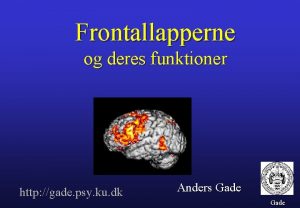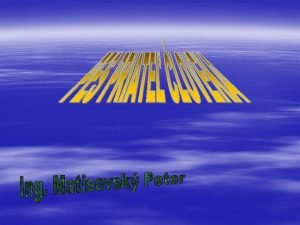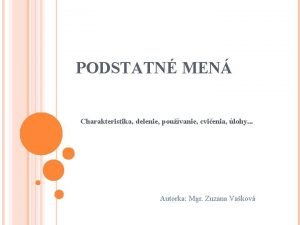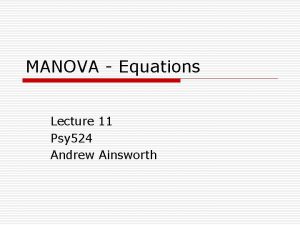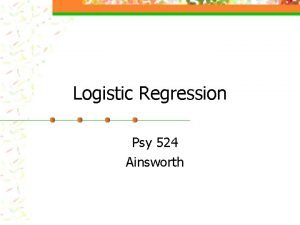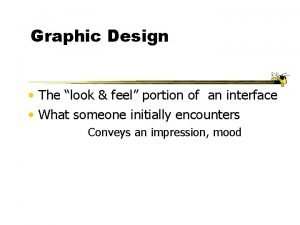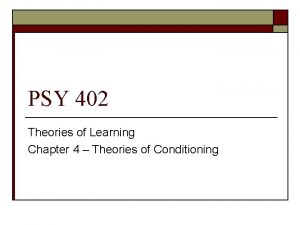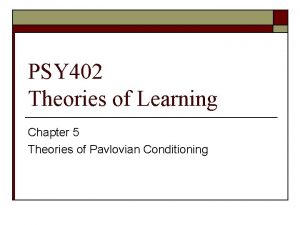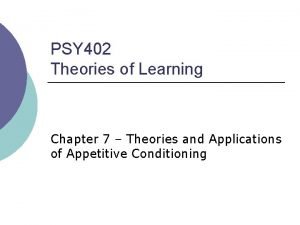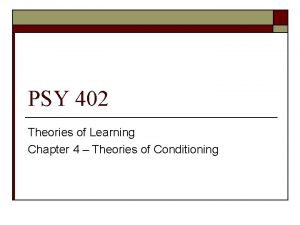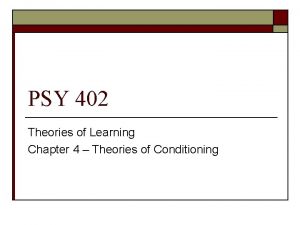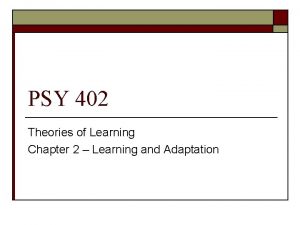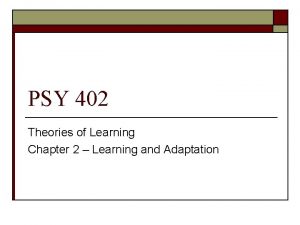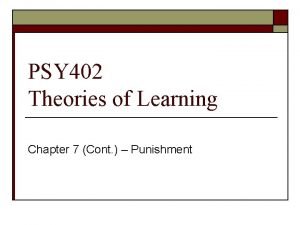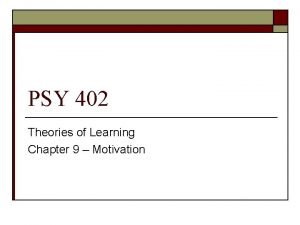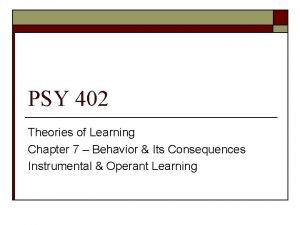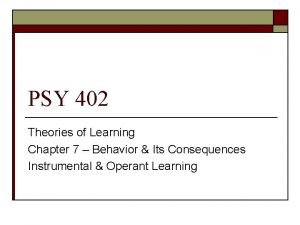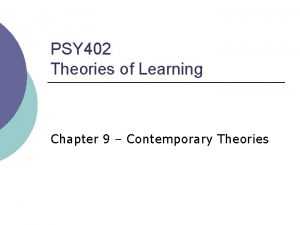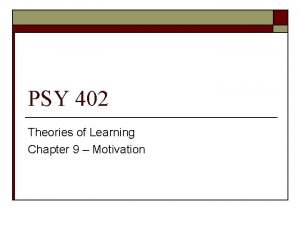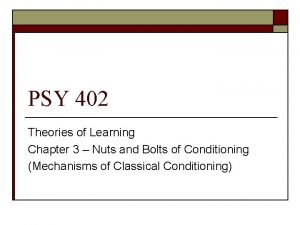PSY 402 Theories of Learning Chapter 4 Theories




















- Slides: 20

PSY 402 Theories of Learning Chapter 4 – Theories of Conditioning

Problems with Rescorla-Wagner o o o It predicts that presenting an inhibitory CS without the UCS should lead to extinction, but it doesn’t. The model cannot account for latent inhibition (preexposure to the CS). Mackintosh demonstrated that animals learn to ignore redundant stimuli – the model doesn’t predict this learning.

The Mackintosh Model o o o Mackintosh proposed that the amount of learning depends on how much attention the animal pays to the CS. The attention to the CS is the a term in the Rescorla-Wagner model. Alpha increases when the CS is the best predictor and conditioning occurs to the best predictor of the UCS.

Criticisms of the Mackintosh Model o o The model does a good job of explaining latent inhibition and its own criticisms of Rescorla-Wagner, but other problems arose. While attention is important, it doesn’t necessarily increase when a CS becomes the best predictor. n Hall & Pearce showed that preexposure to a tone that was a good predictor of weak shock didn’t help learning when a stronger shock was used.

Pearce Hall Model o Animals don’t waste attention on stimuli whose meaning is already well understood. n o Instead, they devote attention to understanding new stimuli. For their model, the value of alpha depends on how surprising the UCS was on the previous trial. n If the UCS is surprising, the CS is not well understood. Alpha is high when this occurs.

Memory and Learning o Wagner extended the Rescorla-Wagner model to incorporate ideas about memory. n n o o A surprising event is an event you are not already thinking about. A surprising event gets more processing and thus is more likely to become part of memory. Priming occurs when an event is already present in short-term memory. Priming reduces surprise.

Kinds of Priming o o Self-generated priming – this occurs when an event primes itself in short-term memory. Retrieval-generated priming – this occurs when a retrieval cue calls an item out of longterm memory. n n Presenting a CS retrieves the UCS associated with it. The CS is thus a retrieval cue for the UCS.

Priming of the US o Ideas about priming provide new explanations for some learning phenomena. n n o Presenting the US before a CS-UCS pairing interferes with learning (pre-exposure to the US). Priming explains this – the US is already present in memory so it is not surprising, and the retrieval cue (CSUS association) is not needed. Learning improves when an intervening stimulus (click & vibration) replaces the US in memory.

Priming of the CS o The revised Rescorla-Wagner model suggests that the surprisingness of the CS is as important as the surprisingness of the UCS. n o Latent inhibition occurs because the CS is not surprising (due to pre-exposure to the CS). Priming of vinegar (the CS) prevents learning, but exposure to vanilla in between enhances learning by replacing vinegar in memory.

Changing the Context o o Due to the long time lapses (24 hrs typically), the CS cannot remain in short-term memory. The context is the cue that retrieves the CS. n n o This is retrieval-generated priming When the context is changed, there is no preexposure effect and learning is normal. When CS preexposure and conditioning occur in different contexts, there is no latent inhibition.

Does Priming Explain Habituation? o o If the response to a stimulus results from its surprisingness, perhaps habituation occurs when the surprise goes away with exposure. Whitlow studied rabbits presented with the same or different tones. n n Habituation occurred, disrupted by a distractor. However, habituation transferred to new contexts – but latent inhibition does not.

Connectionist Views of Memory o Long-term memory consists of associations between representations. n n o o Nodes connected by arrows The US and CS’s and context are all nodes. When a CS is presented, its node is activated – self-generated priming. A node is also activated when something connected to it becomes active – retrieval generated priming.

Wagner’s SOP Model o o o Wagner revised his model to incorporate the “connectionist” idea of memory. SOP – “standard operating procedure” or “sometimes opponent process” Activation of a node has two levels of intensity, A 1 and A 2 (lower level). n n Nodes are A 1 at first, then A 2, then inactive. A node cannot go from A 2 to A 1, just A 1 to A 2.

How the Model Works o A CS and US become associated when both are in stage A 1 at the same time. n o A node is made up of many different elements. Once they are associated, activation of the CS produces A 2 activation of the US. n n The different elements of a node are active to different extents in stages A 1 & A 2. As an association grows, more elements become active when the CS is presented, up to A 2

SOP Explains Timing Effects o o None of the previous models explain why the timing of presentation of CS-US matters. SOP model requires that both CS and UCS be in the A 1 stage for learning to occur. n n With delay more elements of CS decay from A 1. Timing determines the result, including inhibitory and backward conditioning (US is in A 2).

Affective Extension of SOP (AESOP) o Wagner and Brandon noted that US have both sensory and emotional responses. n n o These go through the A 1 & A 2 stages in different amounts of time. Sensory nodes are faster than emotional nodes. Both responses occur during conditioning, but the emotive ones are more likely to become associated with the CS, due to timing.

Pearce’s Configural Theory o o o External inhibition occurs when a CS is conditioned to a US, then an additional CS is added, disrupting previous learning. Pearce explains this as a failure to generalize learning from one CS alone (A) to a compound CS (A-X). We learn a CS as a compound that is a configuration of several nodes, associated as a whole with the US.

Types of Configurations o Positive patterning – two CS’s are associated with the US when paired, but produce no CR when presented separately (one at a time). n o AB produces a CR, but A or B alone do not. Negative patterning – two CS’s are associated with the US independently, but not when paired. n A or B produces a CR, but not AB together.

Elemental Theories o o Elemental theories propose that the many elements of each nodes are each associated with the US. Elemental theories have difficulty predicting findings based on the similarity between compound CS’s. n A+, AB- is easier to learn than AC+, ABC(where more elements are shared).

SOP’s Explanation o o SOP is an elemental theory. SOP proposes that elements are not just added, but some are replaced when two CS’s occur together. n o This changes the experience of the compound CS, especially using the same sensory modality. SOP predicts that removing elements should have a bigger effect than adding them.














